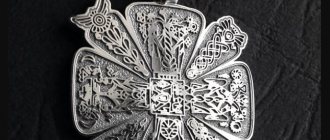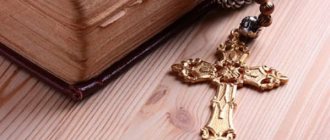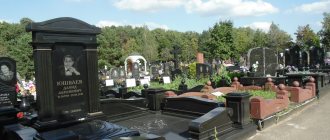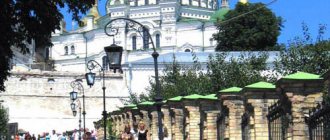The cross is a symbol of faith; it reminds people of the death and ascension of Jesus Christ, the forgiveness that was provided to repentant sinners. The installation of a cross at the burial of an Orthodox person is mandatory. You can order it from a workshop or make it yourself. Heavy wooden or metal crucifixes are placed on a foundation. It is worth learning about how and what to make a wooden grave cross, where to put it after installing the tombstone, in more detail.
Why is it necessary to place a wooden cross on the grave after a funeral?
Death is an important, turning point in the existence of the human soul. Many people believe that life itself is just a preparation for meeting God. The cross is a symbol of such faith. Jesus Christ ascended to it and it marks the burials of all Orthodox Christians. Crosses are not placed on the graves of Muslims.
The grave, which did not have a cross, was previously avoided. The soul of the deceased, even if he were a righteous person, will not easily get to Heaven if it cannot pray one last time before the crucifixion. Saying goodbye to earthly existence and entering a better world after the Last Judgment, a person will take on the cross and thus emerge from the grave. The crucifix is a holy symbol of forgiveness.
There are countless superstitions associated with crucifixes placed on graves. Love spell, conspiracy, damage - all this can be brought on a person using a cross. But the church does not believe in this and does not approve of the desire of the Orthodox to protect themselves from damage with the help of special spells and slander. Salvation must be sought in prayers.
What types of wooden grave crosses are there?
Wood and products made from it are considered vessels for divine power, which is why crucifixes are most often placed on wood, paying attention also to the material from which they are made. Most often it is oak, pine, maple or chestnut. A larch cross on a grave will also be very strong. Its form varies:
- four-pointed (common among Catholics);
- six-pointed patriarchal (a beveled crossbar is attached to the upper part);
- six-pointed Orthodox (the beveled crossbar is attached at the bottom);
- crown of thorns (a crown of thorns is placed in the center of the eight-pointed crucifix);
- grapevine (bunches of grapes entwined with six-pointed Orthodox crucifixes).
Less demand for:
- Greek;
- domed crucifixes with a crescent;
- trefoil;
- Celtic round.
Wood is not as ductile as metal, and its service life is limited, which is why simple, unadorned, four-pointed or six-pointed crosses are often placed on graves.
Materials for production
It is necessary to decide what the grave crucifix will be made of. The entire subsequent process of preparation, and then the actual manufacturing of the product, primarily depends on this.
The most popular materials in our case are wood, metal and stone.
The easiest way is to make a wooden cross yourself. To get a correct and beautiful frame of the model, you will need basic carpentry skills.
If you then want to decorate the almost finished product with carvings, you will also need artistic abilities. At the very end of the work, the wood must be treated with stain and varnished to protect it from the negative effects of the environment.
Metal is a less malleable material than wood and requires very special skills and approaches.
At the same time, it is no less suitable for artistic processing. A skilled craftsman is able to produce very beautiful things from it. The most common method of making a metal grave cross is forging.
Installing a cross is one of the ways to improve a burial site. While the technology for mounting the monument can still be found, there is not so much information regarding the correct installation of the cross. In this article, we will tell you about the main methods used by masters in our time.
What are the dimensions of a wooden cross for a grave?
The Orthodox eight-pointed grave cross made of wood has 4 crossbars, located in relation to each other in accordance with the proportions of the human body. The “golden ratio” rule applies here. The coefficient at which the sides are most harmoniously combined is 1.618 meters. In this case, the length of the longitudinal crossbar is the indicated 1.618 meters, and the size of the upper crossbar is 35-38 cm. A distance of 25-25 cm is left between the two transverse crossbars. About 14-15 cm remains from the top of the longitudinal crossbar to the center of the crossbar.
The top crossbar should remind people of the sign hanging on the crucifixion of Christ. It was placed in the same place and reported that the crucified Jesus was the king of the Jews.
The oblique crossbar or foot recedes 50 cm from the ground. It also has its own symbolism. With the help of an oblique crossbar on the cross, the living are reminded of the scales of justice, that all actions committed during life will be assessed and weighed after death according to special criteria. The lower left edge should remind of the thief crucified on the left side of Christ. He repented and was forgiven. Forgiveness is symbolized by the edge of the bar that is directed upward.
Drawing of an eight-pointed cross
The size of a handmade wooden cross for a grave can be any size. But its height and width affect the installation method. Heavy massive crucifixes require additional fastening. If this is not done, even an oak cross will be blown away by the first strong gust of wind.
How to make a wooden cross for a grave
For the cross, take several wooden beams. They are pre-treated in a special solution that protects the wood from damage. Self-production will also require some tools. So you will need:
- plane;
- nails or screws;
- screwdriver;
- paint brushes, paint itself;
- saw;
- hammer;
- roulette;
- axe.
Production begins with determining the dimensions. A standard cross has a height of 1.6-1.7 meters. The Church admits that the crucifix can be installed very small - no more than 0.4-1.2 meters in height. It all depends on the availability of the necessary materials and wood. Crossbars are cut out of the beams according to the drawing, and they are connected to each other using nails or a screwdriver. The crucifix may be carved.
If the wood is uneven, you will have to sand the surface. To make the structure harmonious, you need to maintain proportions; you can also make recesses at the intersection of the planks, thanks to which they will fit into one another. In this case, they can be secured with glue. The crucifix will turn out beautiful and less rough. At the final stage, it is painted with special paint and dug into the ground.
If the tree chosen is heavy - oak or pine, then the cross is placed on the foundation. For this:
- dig a hole at least 0.5-0.7 meters deep;
- fill the bottom with stones and pebbles;
- install the lower end of the crucifix in the center;
- the sides are filled with broken brick or stone;
- fill everything with cement mortar.
Painting is carried out after installation or before it, but in this case there is a risk of damage to the paint.
Method No. 1
The first option is to bury the cross. In this case, it is also necessary to waterproof the part of the product that will be located in the ground. The main disadvantage of this method is that the cross is significantly shortened. Considering the high cost of carved crosses, this method is not the best solution to the problem. According to the installation technology, the presented option is similar to cementing the part of the cross located in the ground. This work will only allow you to securely fix the base. This is where the advantages of the method end.
What parameters must be observed
Parameters that are usually followed when producing a tombstone crucifix:
- main bar (length) – 1.6 meters;
- additional cross bar (middle) – 1 meter;
- additional cross bars (upper and lower) – 0.38 meters;
- the distance between the top and the middle is 0.38 meters;
- another 0.5 meters retreat from the ground.
The top bar is attached parallel to the middle one, and the bottom one so that an angle of 45 degrees is obtained. The standard size of an Orthodox cross (cm) is 70:40:5 or 120:60:8.
To create a Catholic crucifix, the main plank is divided into 3 equal parts. Each crossbar has a length equal to 1/3 of the length of the entire column. The width is chosen by eye. But the design looks better if all the planks are the same.
What to do with a wooden cross when installing a monument
A cross, especially a wooden one, does not stand on a grave for long. Usually no longer than 1 year. The wood quickly deteriorates; after a few years, the base in contact with the ground rots and the crucifix falls. The burial remains without a cross, looks untidy and un-Christian. A grave without a crucifix can be accidentally destroyed, covered with earth while digging, or rubbish poured on it. If there is a fence, this will not happen, but a burial consisting of a cross and a grave mound is short-lived. The crucifix is removed and replaced with a metal cross or a monument made of granite or marble.
The remaining unclaimed cross:
- They take it to church and offer it to the poor. There is nothing wrong with installing a previously used cross for burial. If the crucifix is well preserved, you need to talk to the priest and offer to bring it to the church. Employees will independently determine where and to whom to give it. The cost of a wooden cross is low - 3-5 thousand rubles, but if there is no money for a funeral, then sometimes this money is not available either. Crosses are not placed on the graves of people left without a permanent place of residence or deprived of the attention of relatives. If the parish helps with the funeral, then the crucifix given free of charge will definitely come in handy to bury the deceased humanly.
- They are buried next to the grave. The crucifix can be sawn apart and buried parallel to the grave before installing the monument and gravestone.
- They are left, moving to the left or right side of the monument (sometimes mounted behind it). There is nothing wrong with the burial being crowned with both a crucifix and a monument. The cross can be left, especially if it is made of quality materials. Oak or pine will not deteriorate soon.
The Orthodox Church gives believers the right to decide for themselves what exactly they should do with the crucifix. The only thing that is condemned is the appearance of a cross in a landfill. It is not recommended to throw away such things. It's disrespectful. If there is no one to give the crucifix to, and you don’t want to bury it, it is better to burn the cross.
A wooden cross is placed on graves as a temporary cross. After 1 year, it is replaced with a monument or crucifix made of metal. When making it yourself, the proportions of the “golden ratio” are observed. The best material is pine or oak. Having become ownerless, the cross is given to the church for the needs of the poor, buried at the grave, left for burial along with the monument, or burned. You can't throw it away.
Question and answer
What other types of wood are used to make grave crosses?
In Belarus, spruce, larch (in terms of density occupies a middle position between oak and pine), ash, maple, and chestnut are often used.
What is done with a wooden cross after the installation of a permanent monument?
The general rule is this: you cannot throw away the cross. Depending on the condition of the item, it can be given to the church for reuse at a funeral, left in the same area, or burned outside the cemetery.
Sometimes there are grave crosses that are similar to Latin ones, but at the top they have an additional horizontal crossbar. What shape of the cross is this?
Such crosses are called Lorraine crosses. They are of Western European origin.











